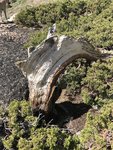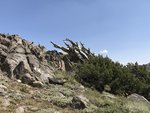Having juniper bark cleaned or leaving it uncleaned is a matter of personal taste.
But, there are good reasons for cleaning it. First off, flaky bark is a good place for insects and molds and algae to grow. Removing the bark removes the hiding places, and you’re likely to have a healthier tree.
Clean junipers usually have a cinnamon color (depends upon the species) that contrasts nicely with the deadwood. Ah! But it’s “not natural”! Wrong! If you go into the mountains, you will see that the live bark is relatively smooth, and brown! The harsh winds and driving snow exfoliates the bark. Naturally! The flaky bark persists in our gardens because we provide a more protected environment, which is NOT the natural habitat for mountain junipers.






